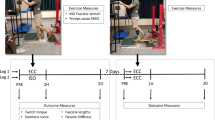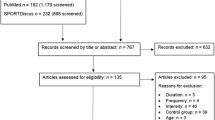Abstract
It is generally accepted that eccentric exercise, when performed by a muscle that is unaccustomed to that type of contraction, results in a delayed onset of muscle soreness (DOMS). A prolonged exposure to eccentric exercise leads to the disappearance of the signs and symptoms associated with DOMS, which has been referred to as the repeated bout effect (RBE). Although the mechanisms underlying the RBE remain unclear, several mechanisms have been proposed, including the serial sarcomere number addition following exercise induced muscle damage. In the traditional DOMS and RBE protocols, muscle injury has been treated as a global parameter, with muscle force and strain assumed to be uniform throughout the muscle. To assess the effects of muscle-tendon unit strain, fiber strain, torque and injury on serial sarcomere number adaptations, three groups of New Zealand White (NZW) rabbits were subjected to chronic repetitive eccentric exercise bouts of the ankle dorsiflexors for 6 weeks. These eccentric exercise protocols consisted of identical muscle tendon unit (MTU) strain, but other mechanical factors were systematically altered. Following chronic eccentric exercise, serial sarcomere number adaptations were not identical between the three eccentric exercise protocols, and serial sarcomere number adaptations were not uniform across all regions of the muscle. Peak torque and relaxation fiber strain were the best predictors of serial sarcomere number across all three protocols. Therefore, MTU strain does not appear to be the primary cause for sarcomerogenesis, and differential adaptations within the muscle may be explained by the nonuniform architecture of the muscle, resulting in differential local fiber strains.






Similar content being viewed by others
References
Barash IA, Mathew L, Ryan AF, Chen J, Lieber RL (2003) Rapid muscle-specific gene expression changes after a single bout of eccentric contractions in the mouse. Am J Physiol Cell Physiol
Barash IA, Peters D, Friden J, Lutz GJ, Lieber RL (2002) Desmin cytoskeletal modifications after a bout of eccentric exercise in the rat. Am J Physiol Regul Integr Comp Physiol 283:R958–R963
Brockett CL, Morgan DL, Gregory JE, Proske U (2002) Damage to different motor units from active lengthening of the medial gastrocnemius muscle of the cat. J Appl Physiol 92:1104–1110
Brown SJ, Child RB, Day SH, Donnelly AE (1997) Exercise-induced skeletal muscle damage and adaptation following repeated bouts of eccentric muscle contractions. J Sports Sci 15:215–222
Burkholder TJ (2001) Age does not influence muscle fiber length adaptation to increased excursion. J Appl Physiol 91:2466–2470
Burkholder TJ, Lieber RL (1998) Sarcomere number adaptation after retinaculum transection in adult mice. J Exp Biol 201(Part 3):309–316
Butterfield TA, Herzog W (2004) Is the force–length relationship a useful indicator of contractile element damage following eccentric exercise? J Biomech 38(9):1932–1937
Butterfield TA, Herzog W (2005a) Alterations in the starting length and activation timing of muscle influence fiber strain and muscle injury. J Appl Physiol—in revision JAP00524-2005
Butterfield TA, Herzog W (2005b) Differential serial sarcomere number adaptations in knee extensor muscles of rats is contraction type dependent. J Appl Physiol doi:10.1152/japplphysiol.00481.2005
Butterfield TA, Herzog W (2005c) Quantification of muscle fiber strain during in-vivo repetitive stretch-shortening cycles. J Appl Physiol 99:593–602
De Deyne PG (2001) Application of passive stretch and its implications for muscle fibers. Phys Ther 81:819–827
Goldspink G (1998) Cellular and molecular aspects of muscle growth, adaptation and ageing. Gerodontology 15:35–43
Goldspink G, Tabary C, Tabary JC, Tardieu C, Tardieu G (1974) Effect of denervation on the adaptation of sarcomere number and muscle extensibility to the functional length of the muscle. J Physiol 236:733–742
Hortobagyi T, Barrier J, Beard D, Braspennincx J, Koens P, Devita P, Dempsey L, Lambert J (1996) Greater initial adaptations to submaximal muscle lengthening than maximal shortening. J Appl Physiol 81:1677–1682
Hortobagyi T, Houmard J, Fraser D, Dudek R, Lambert J, Tracy J (1998) Normal forces and myofibrillar disruption after repeated eccentric exercise. J Appl Physiol 84:492–498
Hough T (1902) Ergographic Studies in Muscle Soreness. Am J Physiol 7:76–92
Jones C, Allen T, Talbot J, Morgan DL, Proske U (1997) Changes in the mechanical properties of human and amphibian muscle after eccentric exercise. Eur J Appl Physiol Occup Physiol 76:21–31
Koh TJ, Brooks SV (2001) Lengthening contractions are not required to induce protection from contraction-induced muscle injury. Am J Physiol Regul Integr Comp Physiol 281:R155–R161
Koh TJ, Herzog W (1998a) Eccentric training does not increase sarcomere number in rabbit dorsiflexor muscles. J Biomech 31:499–501
Koh TJ, Herzog W (1998b) Excursion is important in regulating sarcomere number in the growing rabbit tibialis anterior. J Physiol 508(Part 1):267–280
Koh TJ, Herzog W (1998c) Increasing the moment arm of the tibialis anterior induces structural and functional adaptation: implications for tendon transfer. J Biomech 31:593–599
Koh TJ, Leonard TR (1996) An implantable electrical interface for in vivo studies of the neuromuscular system. J Neurosci Methods 70:27–32
Koh TJ, Peterson JM, Pizza FX, Brooks SV (2003) Passive stretches protect skeletal muscle of adult and old mice from lengthening contraction-induced injury. J Gerontol A Biol Sci Med Sci 58:592–597
Lapier TK, Burton HW, Almon R, Cerny F (1995) Alterations in intramuscular connective tissue after limb casting affect contraction-induced muscle injury. J Appl Physiol 78:1065–1069
Lieber RL, Friden J (2002) Morphologic and mechanical basis of delayed-onset muscle soreness. J Am Acad Orthop Surg 10:67–73
Lieber RL, Woodburn TM, Friden J (1991) Muscle damage induced by eccentric contractions of 25% strain. J Appl Physiol 70:2498–2507
Lieber RL, Yeh Y, Baskin RJ (1984) Sarcomere length determination using laser diffraction Effect of beam and fiber diameter. Biophys J 45:1007–1016
Lindsey CA, Makarov MR, Shoemaker S, Birch JG, Buschang PH, Cherkashin AM, Welch RD, Samchukov ML (2002) The effect of the amount of limb lengthening on skeletal muscle. Clin Orthop 278–287
Lund H, Vestergaard-Poulsen P, Kanstrup IL, Sejrsen P (1998) Isokinetic eccentric exercise as a model to induce and reproduce pathophysiological alterations related to delayed onset muscle soreness. Scand J Med Sci Sports 8:208–215
Lynn R, Morgan DL (1994) Decline running produces more sarcomeres in rat vastus intermedius muscle fibers than does incline running. J Appl Physiol 77:1439–1444
Lynn R, Talbot JA, Morgan DL (1998) Differences in rat skeletal muscles after incline and decline running. J Appl Physiol 85:98–104
Malm C (2001) Exercise-induced muscle damage and inflammation: fact or fiction? Acta Physiol Scand 171:233–239
McHugh MP, Connolly DA, Eston RG, Gartman EJ, Gleim GW (2001) Electromyographic analysis of repeated bouts of eccentric exercise. J Sports Sci 19:163–170
McHugh MP, Connolly DA, Eston RG, Gleim GW (1999) Exercise-induced muscle damage and potential mechanisms for the repeated bout effect. Sports Med 27:157–170
McHugh MP, Tetro DT (2003) Changes in the relationship between joint angle and torque production associated with the repeated bout effect. J Sports Sci 21:927–932
McKay SG, Morck DW, Merrill JK, Olson ME, Chan SC, Pap KM (1996) Use of tilmicosin for treatment of pasteurellosis in rabbits. Am J Vet Res 57:1180–1184
Mendez J, Keys A (1960) Density and composition of mammalian muscle. Metabolism 9:184–188
Morgan DL, Proske U (2004) Popping sarcomere hypothesis explains stretch-induced muscle damage. Clin Exp Pharmacol Physiol 31:541–545
Nosaka K, Clarkson PM (1995) Muscle damage following repeated bouts of high force eccentric exercise. Med Sci Sports Exerc 27:1263–1269
Patel TJ, Lieber RL (1997) Force transmission in skeletal muscle: from actomyosin to external tendons. Exerc Sport Sci Rev 25:321–363
Peters D, Barash I, Burdi M, Yuan PS, Mathew L, Friden J, Lieber RL (2003) Asynchronous functional, cellular and transcriptional changes after a bout of eccentric exercise in the rat. J Physiol
Proske U, Morgan DL (2001) Muscle damage from eccentric exercise: mechanism, mechanical signs, adaptation and clinical applications. J Physiol 537:333–345
Proske U, Morgan DL, Brockett CL, Percival P (2004) Identifying athletes at risk of hamstring strains and how to protect them. Clin Exp Pharmacol Physiol 31:546–550
Prou E, Guevel A, Benezet P, Marini JF (1999) Exercise-induced muscle damage: absence of adaptive effect after a single session of eccentric isokinetic heavy resistance exercise. J Sports Med Phys Fitness 39:226–232
Schwane JA, Armstrong RB (1983) Effect of training on skeletal muscle injury from downhill running in rats. J Appl Physiol 55:969–975
Smith LL (1991) Acute inflammation: the underlying mechanism in delayed onset muscle soreness? Med Sci Sports Exerc 23:542–551
Street SF (1983) Lateral transmission of tension in frog myofibers: a myofibrillar network and transverse cytoskeletal connections are possible transmitters. J Cell Physiol 114:346–364
Tabary JC, Tabary C, Tardieu C, Tardieu G, Goldspink G (1972) Physiological and structural changes in the cat’s soleus muscle due to immobilization at different lengths by plaster casts. J Physiol 224:231–244
Tabary JC, Tardieu C, Tardieu G, Tabary C (1981) Experimental rapid sarcomere loss with concomitant hypoextensibility. Muscle Nerve 4:198–203
Tabary JC, Tardieu C, Tardieu G, Tabary C, Gagnard L (1976) Functional adaptation of sarcomere number of normal cat muscle. J Physiol (Paris) 72:277–291
Taber LA (1998) Biomechanical growth laws for muscle tissue. J Theor Biol 193:201–213
Tardieu C, Tabary JC, Gagnard L, Lombard M, Tabary C, Tardieu G (1974) Change in the number of sarcomeres and in isometric tetanic tension after immobilization of the cat anterior tibialis muscle at different lengths. J Physiol (Paris) 68:205–218
Whitehead NP, Morgan DL, Gregory JE, Proske U (2003) Rises in whole muscle passive tension of mammalian muscle after eccentric contractions at different lengths. J Appl Physiol 95:1224–1234
Williams P, Watt P, Bicik V, Goldspink G (1986) Effect of stretch combined with electrical stimulation on the type of sarcomeres produced at the ends of muscle fibers. Exp Neurol 93:500–509
Williams PE (1988) Effect of intermittent stretch on immobilised muscle. Ann Rheum Dis 47:1014–1016
Williams PE (1990) Use of intermittent stretch in the prevention of serial sarcomere loss in immobilised muscle. Ann Rheum Dis 49:316–317
Williams PE, Catanese T, Lucey EG, Goldspink G (1988) The importance of stretch and contractile activity in the prevention of connective tissue accumulation in muscle. J Anat 158:109–114
Williams PE, Goldspink G (1971) Longitudinal growth of striated muscle fibres. J Cell Sci 9:751–767
Williams PE, Goldspink G (1973) The effect of immobilization on the longitudinal growth of striated muscle fibres. J Anat 116:45–55
Wren TA (2003) A computational model for the adaptation of muscle and tendon length to average muscle length and minimum tendon strain. J Biomech 36:1117–1124
Acknowledgments
The authors would like to thank Tim Leonard, Hoa Nguyen for their technical assistance, Dr. Motoshi Kaya, the CIHR Training Program in Bone and Joint Health, NSERC of Canada, and the CIHR Research Chair Program.
Author information
Authors and Affiliations
Corresponding author
Rights and permissions
About this article
Cite this article
Butterfield, T.A., Herzog, W. The magnitude of muscle strain does not influence serial sarcomere number adaptations following eccentric exercise. Pflugers Arch - Eur J Physiol 451, 688–700 (2006). https://doi.org/10.1007/s00424-005-1503-6
Received:
Accepted:
Published:
Issue Date:
DOI: https://doi.org/10.1007/s00424-005-1503-6




